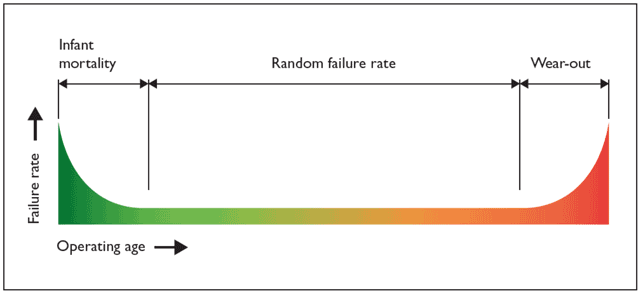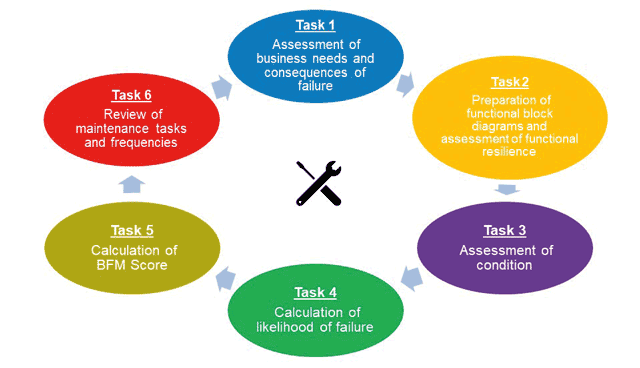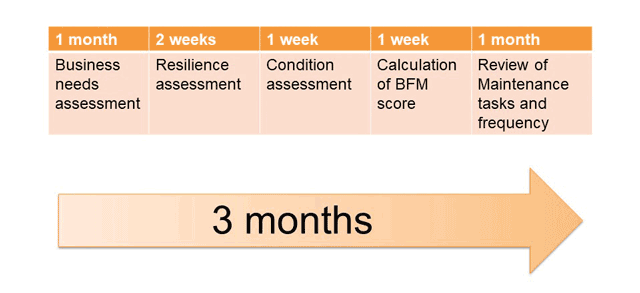Why do maintenance? To keep assets in optimum working condition? to make equipment last longer? to prevent failures? If it is for any of these reasons you may be working to an outdated ethos, says BSRIA principal FM consultant Nick Blake.
BSRIA employs a pragmatic approach for today’s business needs. Business-focused maintenance recognises that building services equipment is installed to provide a service, thereby allowing a business function to be maintained. It analyses the business needs and consequences of failure first and foremost. This ensures that business function is maintained with the minimum of intrusive maintenance, to minimise maintenance-induced failure; otherwise it is traditionally assumed that the asset failure profile follows the bathtub curve below.
Though BSRIA has developed BFM for application to building services equipment, the principles can be applied more generally.

BFM recognises that the need for maintenance generally arises from business needs such as complying with legislation; minimising health and safety risks; managing business continuity; for responding to business and customer requirements; adding value and reducing overall business costs; for minimising whole life cost; and increasing asset and system availability.
Users of BFM – first published as a BSRIA Guide in 2004 – have demonstrated increased system availability and greatly reduced costs. There is a structured, six-step process to follow in which the client and BSRIA work collaboratively, as follows:
1: Assess business needs and consequences of asset failure
The goals of the business and the needs of users are assessed to ascertain which assets are crucial, and therefore the impact on the business of assets failing. The structure of BFM allows for this task to be done as objectively as possible and logged on a numeric scale of 1-10 from low to high impact.
2: Document functional block diagrams and assess functional resilience
Systems are reviewed and their ability to continue to meet the needs of the business when a failure occurs is assessed.
3: Assess asset condition
A full condition survey to BG 35/2012, taking into account all relevant influences on an assets condition, to provide a remaining life expectancy.
4. Calculate likelihood of failure
This converts the alphanumeric score from tasks 1, 2 and 3 to a 1-10 score via conversion table 6 in the BFM guide BG 53/2016 – see below.

5. Calculate BFM score
Combine the score from task 1 (BC) with the number calculated in task 4 (L) to give a BFM risk score on a scale of 1-100:

6. Review of PPM tasks and frequency
Apply scores to the agreed level of risk set by the organisation. From this a revised maintenance schedule can be drawn up. BG 53/2016 suggests the following:
1-9 Discretionary maintenance for non-critical assets
10-40 Legal compliance and sector specific requirements
41-100 Maintenance to provide the greatest level of confidence in asset reliability, performance and availability.
Although every job is different, an indicative timeline shows that BFM can very quickly make an impact on a business.
The business-focused maintenance methodology challenges the planned preventive maintenance frequency of building services plant. The assessment methodology takes into account plant history, the number of standby plant items, and the level of resources available.

Many intrusive maintenance tasks can be replaced by condition monitoring (CM) which in turn leads to condition based maintenance (CBM). CM is far quicker in staff hours than time-based PPM tasks, often involves zero downtime and therefore has no impact on the business.

Regular use of these methods at appropriate intervals can be far more cost effective than regular time-based generic intervals, whereas for non-critical plant, the most cost-effective maintenance methodology may be to run to failure. By applying the BFM methodology, you can be confident that you have selected the most appropriate maintenance technique for the services in your building.

